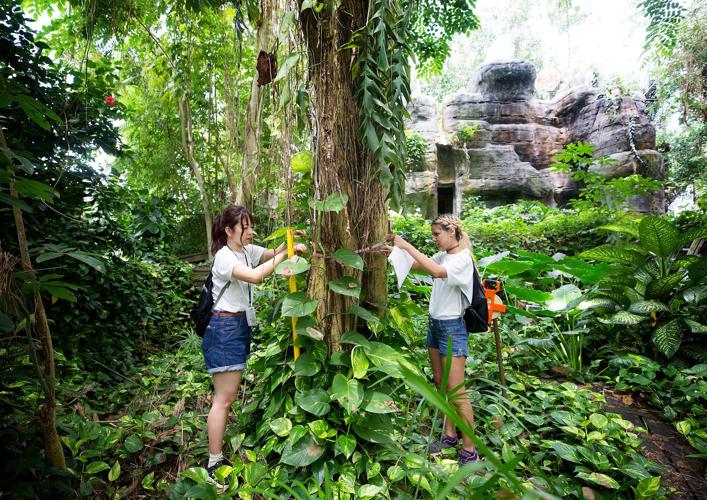The tropical rain forest section of the UA’s Biosphere 2 is closed to the public for four months as researchers conduct a study on drought.
The remaining areas under glass in the Biosphere, near Oracle north of Tucson, will remain open to the public during this time.
The closure of the rain forest is to allow for an experiment, known as Water, Atmosphere and Life Dynamics, to be conducted by an international team of researchers using an array of instruments.
The study is expected to shed light on how tropical ecosystems will fare under the stress of a hotter, drier shift in climate, according to a news release from the UA.
The experiment is part of a $2.1 million, five-year European Research Council grant acquired by Christiane Werner, a professor of ecosystem physiology at Germany’s University of Freiburg and one of the project leads. Junior investigator Nemiah Ladd, also of Freiburg, co-organized the grant and is another project lead along with Laura Meredith, the rain forest science director for Biosphere 2.
Normally, the Biosphere 2 rain forest receives 5,300 gallons of rain — enough to fill more than 65 bathtubs — three times per week. This month, Meredith and the team will take measurements and observe the forest under normal conditions before shutting off the rain in October.
The team will track how carbon dioxide and water vapor flow through the system before and after the artificial drought, which will allow researchers to understand how the rain forest will respond to the stress, Werner said.
The researchers said this kind of science can only be done in a place like Biosphere 2.
The international team will also genetically characterize the microbial communities living in the soils and leaves and measure how volatile organic compounds, organic chemicals that float through the air and are known as VOCs, move through the ecosystem under the different conditions.
Meredith said they expect to find that plants use carbon in different ways under stress. She also expects plants, soil and microbes to create different VOCs, than they do under normal conditions and indicated they could possibly even discover new types of VOCs.
“What I like about Biosphere 2 is that it has grown naturally for so long,” Werner said, adding the ecosystem’s longevity makes it a more reliable proxy for a rain forest than a lab.
“Biosphere 2 is a place of limitless possibilities and hyper imagination,” Meredith said.
Photos: Apollo 14 astronaut training in Arizona, 1970
Apollo 14 astronaut training in Arizona
Updated
Astronaut Alan Shepard walks the edge of a man-made crater during NASA training simulation near Cottonwood, Ariz., in Nov., 1970, of the Apollo 14 landing on Fra Mauro on surface of the Moon
Apollo 14 astronaut training in Arizona
Updated
Local media with film cameras talk with astronauts Edgar Dean Mitchell and Alan Shepard during NASA training simulation near Cottonwood, Ariz., in Nov., 1970, of the Apollo 14 landing on Fra Mauro on surface of the Moon. Crouching in foreground is legendary ABC science reporter Jules Bergman.
Apollo 14 astronaut training in Arizona
Updated
Astronauts Alan Shepard, left, and Edgar Dean Mitchell walk the edge of a man-made crater during NASA training simulation near Cottonwood, Ariz., in Nov., 1970, of the Apollo 14 landing on Fra Mauro on surface of the Moon. A very simple model of the Lunar Module can be seen background right.
Apollo 14 astronaut training in Arizona
Updated
Astronauts Edgar Dean Mitchell and Alan Shepard gather samples in a man-made crater during NASA training simulation near Cottonwood, Ariz., in Nov., 1970, of the Apollo 14 landing on Fra Mauro on surface of the Moon
Apollo 14 astronaut training in Arizona
Updated
A very simple model of an Apollo Lunar Module sits above astronauts Edgar Dean Mitchell and Alan Shepard as they take samples using a Modular Equipment Transporter during NASA training simulation near Cottonwood, Ariz., in Nov., 1970, of the Apollo 14 landing on Fra Mauro on surface of the Moon
Apollo 14 astronaut training in Arizona
Updated
Alan Shepard, left, one of the original Mercury astronauts, and Edgar Dean Mitchell chat with reporters during NASA training simulation near Cottonwood, Ariz., in Nov., 1970, of the Apollo 14 landing on Fra Mauro on surface of the Moon
Apollo 14 astronaut training in Arizona
Updated
Astronaut Edgar Dean Mitchell leads Alan Shepard pushing a Modular Equipment transporter in a crater near Cottonwood, Ariz., during NASA training simulation in Nov., 1970, of the Apollo 14 landing on Fra Mauro on surface of the Moon
Apollo 14 astronaut training in Arizona
Updated
Using a Lunar Equipment Transporter, astronauts Alan Shepard, left, and Edgar Dean Mitchell compile data during a NASA training simulation near Cottonwood, Ariz., in Nov., 1970, of the Apollo 14 landing on Fra Mauro on surface of the Moon





